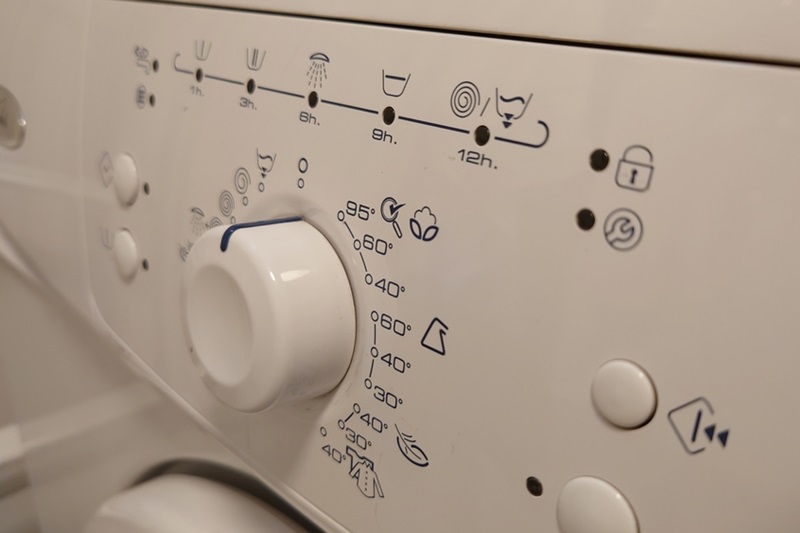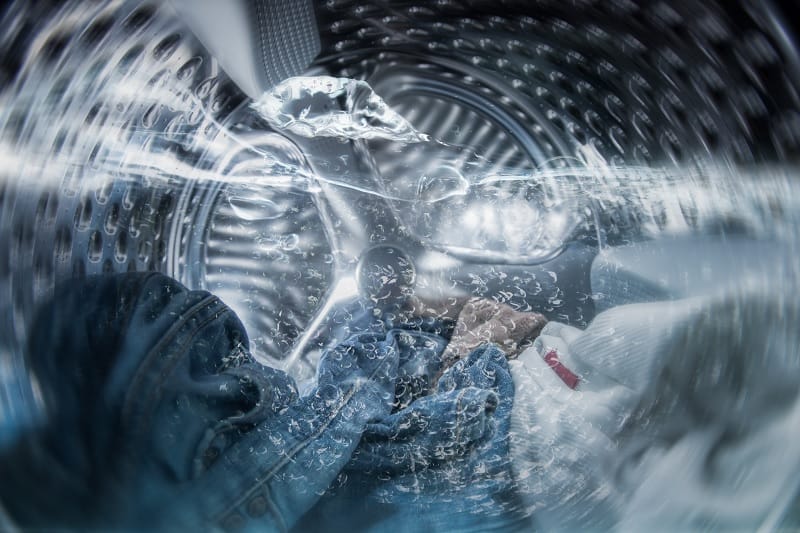It’s safe to say that washing machines have come a long way in recent years. Their use of technology has changed how we clean laundry, how efficient the machines are, and how easy the appliances are to use.
One cycle that’s got tongues wagging is the ‘Anti Stain’ one. So, what does this ‘Anti Stain’ setting do?
In short, the ‘Anti Stain’ cycle essentially optimises water use and temperature, as well as detergent dispensing and drum rotation to remove blemishes from laundry.
It’s supposed to speed up the stain removal process, so you don’t have to waste time treating marks on your laundry before washing it.
What Is Anti Stain Technology?
If you’ve got an ‘anti stain’ feature on your washing machine, it just means that your appliance can target and remove troubling stains from your dirty laundry.
It’s a rather unique setting that uses a combination of precise temperature control, drum rotation and water management, as well as detergent distribution techniques to effectively tackle and remove stains from washing. Essentially, the stains in question wouldn’t come out in a ‘normal’ wash.
Let’s look at this in more detail.
How does anti stain technology work?
To remove stains, a washing machine running an anti stain cycle must take full advantage of the following:
Precise temperature control
Different stains require different water temperatures. Some stains require hot water, while others need cold water.
The precise temperature control feature ensures that the water running inside the machine during an anti stain cycle is suitable for the stain that needs treating.
The machine can adjust the water temperature to ensure the blemish is treated using an optimal water temperature.
Water management
To maximise stain removal, the anti stain setting manages the water levels inside the machine and controls how the water is distributed throughout the appliance.
This ensures that the detergent always gets to the target area and that the blemish isn’t spread around and onto other garments in the drum.
Optional detergent dispensing
Anti stain cycles gradually release detergent into the washing machine’s drum throughout the cycle.
This ensures that the detergent is evenly distributed and can work on removing the stains continuously throughout the cycle.
Drum control
The drum’s motion is also controlled by the anti stain cycle. So, it can increase or decrease agitation depending on the load size and amount of staining it has to handle.
What Stains Can an Anti Stain Cycle Treat?
The anti stain cycle can treat a variety of stains including, but not limited to:
- Tea
- Coffee
- Blood
- Grass
- Wine
- Food
Can You Use Regular Detergent When Running an Anti Stain Cycle?
Yes, you can use regular detergent when running an anti stain cycle through your washing machine.
However, if you want to see the best results, it would be worth using a detergent capable of removing tough stains to maximise the anti stain cycle’s abilities.
In addition, take note of the following points:
- You must use the correct dose of detergent. Weigh out your load of washing and add the right amount of detergent to the machine. If you use too much or too little cleaner, it will impact how the anti stain cycle works.
- Make sure you add detergent to the correct compartment in the detergent drawer. By adding the detergent to the right compartment, the anti stain cycle will be able to dispense it at optimal times to ensure the stains are treated properly.
- For really tough stains, it may be worth pre-treating them with detergent before running them through an anti stain cycle. This extra step will enhance the anti-stain cycle’s performance.
- Always consult your user handbook before you use the anti stain cycle on your washer. The guidebook may give specific instructions on what you must/must not add or do to your appliance when running an anti stain cycle.
What Are the Limitations of an Anti Stain Cycle?
The main drawback of the anti stain cycle is that it cannot always remove aged and extremely stubborn stains.
In this case, you might have to run your load through a second program to remove the whole blemish.
In other cases, you’ll have to pre-treat the stain on your garment and then run it through an anti stain cycle to see a significant result. For example, you might have to soak your item in a tub of solution beforehand or treat the mark with an off-the-shelf stain remover.
It’s not a dealbreaker, but this is additional work for you. It’ll take more time to treat the blemish and, perhaps, extra expense.
In addition, you might not be able to run delicate materials, like silks and wools, through this cycle because it’s unsuitable for them. Again, if you get a stain on these garments, you’ll have to find an alternative way of treating them, which is inconvenient and creates needless work for you.
Does the Anti Stain Cycle Consume More Water and Energy Than a Normal Cycle?
The anti stain cycle is designed to be as effective and efficient as possible. It aims to make the most use of water and energy.
Given that the anti-stain cycle aims to target and remove stains, it can sometimes use fewer resources compared to running multiple ‘normal’ washing cycles to remove the same type of stain.
However, each washing machine’s consumption will vary depending on the make and model of the machine, the specific anti stain technology that’s being used, and how the machine is used by the user.
For a more precise understanding of how much energy and water your machine uses when running an anti stain cycle, you should read your user manual and monitor your bills. To make extra savings, use the eco mode on your appliance wherever possible.
Consider the following points:
Water consumption
- The anti stain cycle has been designed to use water more efficiently to target specific stains. So, instead of filling the drum with water each time, it adjusts the water levels to suit the load. This can often lead to less water being used.
- The majority of anti stain cycles have load and soil sensing technology built into them. The machine can utilise these features to work out how big the load is and how soiled the laundry is so it can add enough water to the machine to clean the stained washing. Again, this may lead to less water being used for smaller loads.
Energy consumption
- The anti stain cycle adjusts the water temperature during the cycle so that it uses the best water temperature based on the type of stain it has to deal with. This can lead to some energy savings because the machine doesn’t have to heat the water to unnecessarily hot temperatures often.
- Anti stain cycles focus on removing stains from laundry. By focusing solely on sorting stains out, some anti stain cycles can be pretty short, and a wash can be completed in much less time. This can save you time and energy in the long term.
Can You Treat All Fabrics Using the Anti Stain Cycle?
While the anti stain cycle can be used to clean stains from a wealth of materials, you must always read the care labels on your items before you wash them using this cycle.
Not all materials, like delicate ones, can withstand an anti stain cycle because they require a gentler kind of program. If you were to wash such clothes on this type of cycle, they could end up shrunk or damaged.
Take note of the following:
- Read the care label on your clothes and adhere to the instructions. And if you’re in doubt, skip the anti stain cycle and treat your stain in a different way.
- It might be better to skip this cycle if you’re cleaning a delicate piece. When cleaning delicate materials, using some of the other specialised programs on your washing machine, like the ‘hand wash’ or ‘delicate’ cycles, makes more sense.
- If your items aren’t soiled, there’s very little point in using the anti stain feature. It would be a waste. You might as well use a ‘normal’ wash to clean your lightly soiled laundry.
- Don’t mix your fabrics and then run an anti stain cycle. It’s better to separate your load into smaller, specific washes and then clean them. This will prevent you from using the wrong water temperature to wash your garments.

Bethan has a passion for exploring, reading, cooking and gardening! When she’s not creating culinary delights for her family, she’s concocting potions to keep her house clean!






